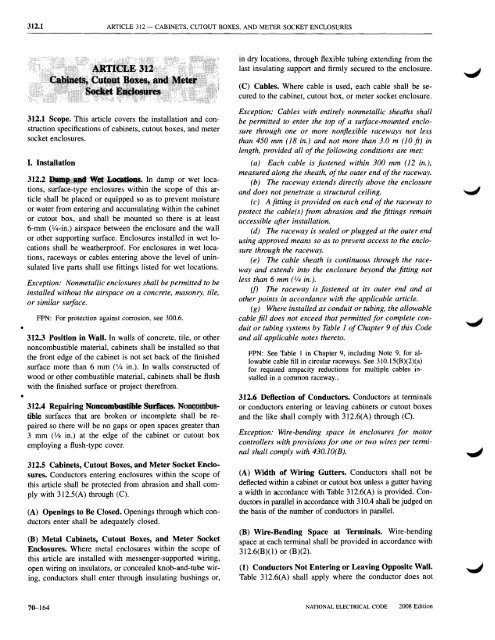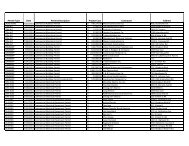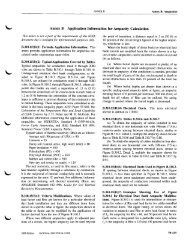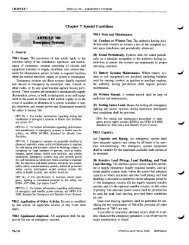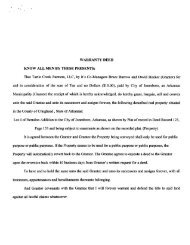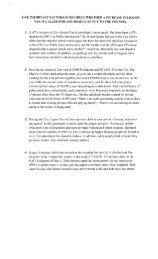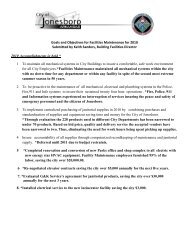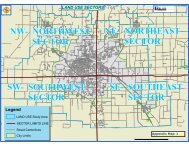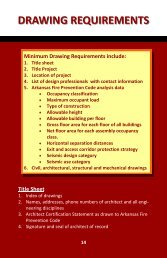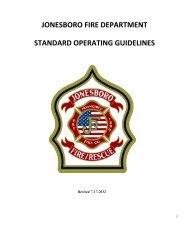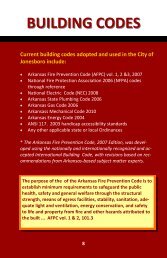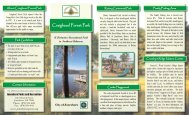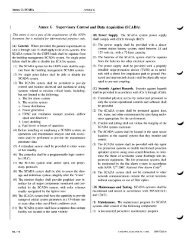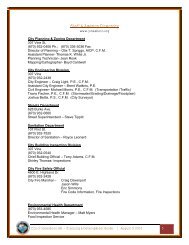Chapter 3 Wiring Methods and Materials
Chapter 3 Wiring Methods and Materials
Chapter 3 Wiring Methods and Materials
Create successful ePaper yourself
Turn your PDF publications into a flip-book with our unique Google optimized e-Paper software.
312.1 ARTICLE 312 - CABINETS, CUTOUT BOXES, AND METER SOCKET ENCLOSURES<br />
in dry locations, through flexible tubing extending from the<br />
last insulating support <strong>and</strong> firmly secured to the enclosure.<br />
...."<br />
(C) Cables. Where cable is used, each cable shall be secured<br />
to the cabinet, cutout box, or meter socket enclosure.<br />
312.1 Scope. This article covers the installation <strong>and</strong> construction<br />
specifications of cabinets, cutout boxes, <strong>and</strong> meter<br />
socket enclosures.<br />
I. Installation<br />
312.2..I!i....(:~~. In damp or wet locations,<br />
surface-type enclosures within the scope of this article<br />
shall be placed or equipped so as to prevent moisture<br />
or water from entering <strong>and</strong> accumulating within the cabinet<br />
or cutout box, <strong>and</strong> shall be mounted so there is at least<br />
6-mm (1I4-in.) airspace between the enclosure <strong>and</strong> the wall<br />
or other supporting surface. Enclosures installed in wet locations<br />
shall be weatherproof. For enclosures in wet locations,<br />
raceways or cables entering above the level of uninsulated<br />
live parts shall use fittings listed for wet locations.<br />
Exception: Nonmetallic enclosures shall be permitted to be<br />
installed without the airspace on a concrete, masonry, tile,<br />
or similar surface.<br />
FPN: For protection against corrosion. see 300.6.<br />
•<br />
312.3 Position in WaH. In walls of concrete, tile, or other<br />
noncombustible material, cabinets shall be installed so that<br />
the front edge of the cabinet is not set back of the finished<br />
surface more than 6 mm (1/4 in.). In walls constructed of<br />
wood or other combustible material, cabinets shall be flush<br />
with the finished surface or project therefrom.<br />
•<br />
312.4 Repairing 'Noncombd$ttWe~.p~.NqAtlmbq~<br />
ub!e surfaces that are broken or incomplete shall be repaired<br />
so there will be no gaps or open spaces greater than<br />
3 mm (118 in.) at the edge of the cabinet or cutout box<br />
employing a flush-type cover.<br />
312.5 Cabinets, Cutout Boxes, <strong>and</strong> Meter Socket Enclosures.<br />
Conductors entering enclosures within the scope of<br />
this article shall be protected from abrasion <strong>and</strong> shall comply<br />
with 312.5(A) through (C).<br />
(A) Openings to Be Closed. Openings through which conductors<br />
enter shall be adequately closed.<br />
(B) Metal Cabinets, Cutout Boxes, <strong>and</strong> Meter Socket<br />
Enclosures. Where metal enclosures within the scope of<br />
this article are installed with messenger-supported wiring,<br />
open wiring on insulators, or concealed knob-<strong>and</strong>-tube wiring,<br />
conductors shall enter through insulating bushings or,<br />
Exception: Cables with entirely nonmetallic sheaths shall<br />
be permitted to enter the top of a surface-mounted enclosure<br />
through one or more nonfiexible raceways not less<br />
than 450 mm (18 in.) <strong>and</strong> not more than 3.0 m (10 ft) in<br />
length, provided all of the following conditions are met:<br />
(a) Each cable is fastened within 300 mm (12 in.).<br />
measured along the sheath, ofthe outer end ofthe raceway.<br />
(b) The raceway extends directly above the enclosure<br />
<strong>and</strong> does not penetrate a structural ceiling.<br />
(c) Afitting is provided on each end of the raceway to<br />
protect the cable(s) from abrasion <strong>and</strong> the fittings remain<br />
accessible after installation.<br />
(d) The raceway is sealed or plugged at the outer end<br />
using approved means so as to prevent access to the enclosure<br />
through the raceway.<br />
(e) The cable sheath is continuous through the raceway<br />
<strong>and</strong> extends into the enclosure beyond the fitting not<br />
less than 6 mm (1/4 in.).<br />
(f) The raceway is fastened at its outer end <strong>and</strong> at<br />
other points in accordance with the applicable article.<br />
(g) Where installed as conduit or tubing, the allowable<br />
cable fill does not exceed that permitted for complete conduit<br />
or tubing systems by Table 1 of <strong>Chapter</strong> 9 of this Code<br />
<strong>and</strong> all applicable notes thereto.<br />
FPN: See Table I in <strong>Chapter</strong> 9, including Note 9, for al<br />
lowable cable fill in circular raceways. See 310.15(B)(2)(a)<br />
for required ampacity reductions for multiple cables in<br />
stalled in a common raceway.;<br />
312.6 Deflection of Conductors. Conductors at terminals<br />
or conductors entering or leaving cabinets or cutout boxes<br />
<strong>and</strong> the like shall comply with 312.6(A) through (C).<br />
Exception: Wire-bending space in enclosures for motor<br />
controllers with provisions for one or two wires per terminal<br />
shall comply with 430.1O(B).<br />
(A) Width of <strong>Wiring</strong> Gutters. Conductors shall not be<br />
deflected within a cabinet or cutout box unless a gutter having<br />
a width in accordance with Table 312.6(A) is provided. Conductors<br />
in parallel in accordance with 310.4 shall be judged on<br />
the basis of the number of conductors in parallel.<br />
(B) Wire-Bending Space at Terminals. Wire-bending<br />
space at each terminal shall be provided in accordance with<br />
312.6(B)(1) or (B)(2).<br />
(1) Conductors Not Entering or Leaving Opposite Wall.<br />
Table 312.6(A) shall apply where the conductor does not<br />
70--164<br />
NATIONAL ELECTRICAL CODE<br />
2008 Edition


